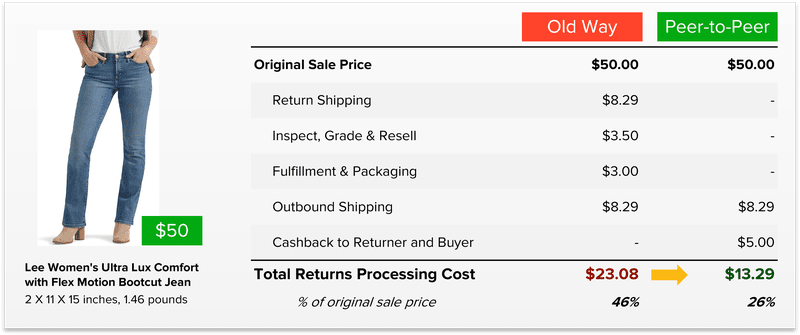Why Are Ecommerce Returns So High? (And What You Can Do About It)

Last updated on April 25, 2025

Ecommerce returns are a growing concern for online businesses, and the high return rates continue to put pressure on profit margins and business operations. In fact, a large portion of ecommerce sales involves items being sent back by customers for various reasons, and these avoidable returns are not just costly; they also have a significant impact on customer satisfaction, customer loyalty, and brand reputation.
Whether you’re an online merchant trying to understand why ecommerce returns are so high or looking for ways to reduce returns, it’s important to understand the contributing factors. This article explores the main reasons ecommerce returns remain high, the effects on profitability, and practical strategies for reducing return rates while improving the customer experience and customer loyalty.
Why Are Ecommerce Returns So High?
1. Incorrect Product Descriptions and Sizing Issues
One of the primary reasons online shoppers return products is that incorrect product descriptions lead to issues with customer orders. Whether it’s a misleading product description, inaccurate sizing guides, or poor-quality images, customers may be disappointed when the product doesn’t match their expectations. This mismatch can result in customer dissatisfaction and returns.
In the fashion ecommerce space, this is especially prevalent. The average ecommerce return rate in the fashion industry is higher than in other sectors due to the challenges customers face in selecting the right size. With no ability to try on products in online stores, many customers end up purchasing multiple items in different sizes, only to return the ones that don’t fit. Customers often purchase the same item in different sizes to ensure a proper fit, which can lead to increased returns and associated costs.
What you can do: Improve product descriptions by providing accurate size charts, detailed product features, and high-quality images that show the product from multiple angles. Offering virtual try-ons and other sizing tools can also help ensure that customers choose the right products the first time.
2. Free Return Shipping and Its Impact on Profitability
The rise of free return shipping policies has made shopping online much more attractive to customers. However, this has also contributed to high return rates. Many customers, knowing they can return items for free, make purchases without fully committing, often purchasing more than they need, with the intention to return items that don’t meet their expectations.
Free returns can encourage more online purchases, but also increase the shipping costs for the business. This creates a significant amount of operational costs that affect profit margins.
What you can do: Consider offering store credit or incentivizing exchanges over returns to reduce the volume of products shipped back. This keeps the returned items in circulation and encourages customers to make future purchases rather than simply refunding them.
3. Buyer’s Remorse and Impulse Buys
Another factor contributing to high return rates is buyer’s remorse. Online shoppers, especially those buying products on impulse, may change their minds once the product arrives. Ecommerce stores with easy return policies contribute to this behavior, as customers know they can return the product without hassle. This often leads to returns for reasons unrelated to the product’s quality.
What you can do: Reduce impulse buys by offering clear, transparent return policies and making customers more informed before they purchase. Ensure that customers are aware of their return window and encourage them to carefully consider their purchases. Offering store credit instead of a full refund can also help mitigate buyer’s remorse.
4. Shipping Delays or Damaged Goods
The shipping process often causes issues for customers that lead to returns, particularly when products arrive late or damaged. Whether it’s a carrier delay, the order shipped late, or simply arrived with damaged goods due to improper packaging or void fill, poor delivery can lead to returns and even result in disproportionate customer dissatisfaction. Online business owners should aim to minimize such occurrences to maintain a positive customer experience.
What you can do: Work with trusted logistics providers to ensure on-time delivery and make sure to use quality packaging that can deliver the items safely. Offer clear communication to customers about the expected delivery dates, and provide them with easy access to your returns portal if issues arise.
5. Fraudulent Returns
Return fraud is a growing issue in ecommerce, contributing to high return rates. Many retailers are adopting stricter return policies to combat return fraud. Customers may take advantage of lenient return policies by returning used or damaged items, or even returning items they didn’t purchase. Return fraud is costly and can impact both profit margins and the customer experience.
What you can do: Implement return fraud detection systems to identify suspicious patterns, monitor return data, and flag potential fraud before it happens. You can also establish stricter return policies, such as requiring customers to provide proof of purchase or a return authorization before accepting returns.
The Impact of High Ecommerce Return Rates on Profitability
1. Lost Sales and Decreased Profit Margins
While ecommerce returns are inevitable, they still lead to lost sales and higher operational costs. When customers return products, the business incurs shipping costs and additional handling costs, which impact the bottom line. Returns also lead to inventory management challenges, as items may need to be restocked, repackaged, or even discarded, depending on their condition.
High return rates can reduce overall profit margins and increase the costs of running an ecommerce business.
2. Operational Complexity and Efficiency
Managing returns efficiently is a significant challenge for many online stores. With high return rates, business operations become more complex, leading to additional staffing needs and greater logistical hurdles. Processing returns manually can delay orders, create inventory visibility issues, and lead to inefficiencies in order fulfillment.
By optimizing the returns management process through better planning and automation, businesses can reduce operational inefficiencies and improve the customer experience.
Strategies to Reduce Returns and Improve Profitability
1. Offer Accurate Product Descriptions and Size Guides
As mentioned earlier, one of the most common causes of returns is incorrect sizing or product mismatch. Provide accurate, detailed product descriptions and comprehensive size charts to help customers make the right choice the first time. Ecommerce stores that invest in providing these resources will see a reduction in return rates and an improvement in customer satisfaction.
Pro Tip: Use customer data to personalize product recommendations, reducing the chance of customers purchasing items that are likely to be returned.
2. Implement a Strong Returns Management System
Returns management is a crucial aspect of maintaining a positive customer experience while keeping costs under control. Implement a returns management system that helps streamline the return process by automating the approval process, tracking return data, and providing real-time updates to customers. This reduces the time spent on processing returns and helps improve operational efficiency.
3. Offer Exchanges Instead of Refunds
Encouraging customers to exchange items rather than return them for a full refund can help keep products in circulation. Offering store credit for returns instead of refunds helps businesses retain revenue while still meeting customer expectations. This approach also helps boost repeat purchases and increase customer loyalty.
4. Leverage Technology to Reduce Returns
Technology such as AI, augmented reality, and machine learning can help businesses predict potential returns before they happen. By offering virtual try-ons for fashion items or AI-driven size recommendations, businesses can help customers make better decisions and reduce the likelihood of returns due to incorrect sizing or dissatisfaction.
Role of Customer Feedback
Customer feedback plays a vital role in reducing ecommerce returns. By collecting and analyzing customer feedback, online merchants can identify areas for improvement, such as inaccurate product descriptions or sizing issues. Customer feedback can also help ecommerce stores develop targeted strategies to reduce returns, such as providing detailed size charts or offering alternative products during the returns process. Furthermore, customer feedback can be used to improve product descriptions, images, and overall customer experience, leading to increased customer satisfaction and loyalty. By leveraging customer feedback, ecommerce stores can reduce returns, improve operational efficiency, and drive business growth.
Conclusion
High ecommerce return rates pose a serious challenge to profit margins and customer satisfaction. By understanding the factors contributing to high return rates, ecommerce businesses can implement strategies to reduce these returns, such as offering accurate product descriptions, utilizing returns management systems, and encouraging exchanges over refunds. Additionally, offering store credit and improving the customer experience post-purchase can significantly improve customer loyalty and repeat purchases.
Through careful planning and the use of technology, online merchants can manage returns effectively, reduce the associated costs, and ultimately maximize profitability while creating a competitive edge in the global ecommerce market.
Frequently Asked Questions
Why are ecommerce return rates so high?
Ecommerce return rates are high due to inaccurate product descriptions, sizing issues, buyer’s remorse, and the prevalence of free returns policies that encourage customers to buy more items without fully committing.
How can I reduce returns in ecommerce?
To reduce return rates, ensure accurate product descriptions, offer detailed size charts, and implement virtual try-ons. Encourage exchanges instead of refunds and use data analytics to personalize recommendations.
How does return fraud affect ecommerce businesses?
Return fraud increases operational costs by encouraging fraudulent returns, such as customers returning used or damaged goods. Implementing fraud detection systems and more stringent return policies can help reduce fraud. Additionally, preventing return fraud can help retain loyal customers by ensuring a fair and trustworthy shopping experience.
How can a returns management system improve profitability?
An ecommerce store can improve profitability by implementing a returns management system that automates the returns process, tracks return data, and improves inventory management, all of which reduce operational costs and improve profit margins by streamlining the process.
What role does customer loyalty play in reducing returns?
By providing a seamless return process, offering store credit, and improving customer satisfaction, businesses can build customer loyalty, which in turn leads to repeat purchases and fewer returns in the future. A seamless return process can also encourage customers to buy online, knowing they can easily return items in physical stores, thus enhancing customer satisfaction and reducing the likelihood of future returns.

Up to 64% Lower Returns Processing Cost


 9 minutes
9 minutes